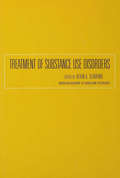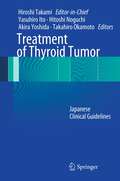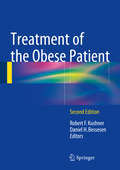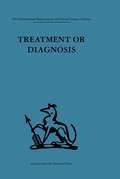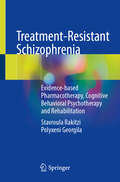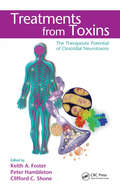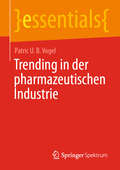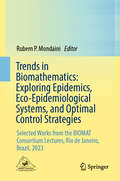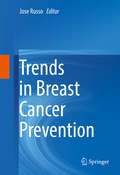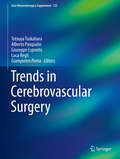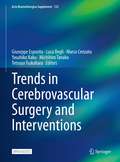- Table View
- List View
Treatment of Substance Abuse: Psychosocial Occupational Therapy Approaches
by Diane GibsonThis timely volume fills a long-standing gap in the professional literature by providing an overview of contemporary assessment and rehabilitation of alcohol and chemical dependent substance abusers. Although many occupational therapists and other activity therapy staff work in substance abuse programs, few articles in occupational therapy literature address this relevant topic. Treatment of Substance Abuse: Psychosocial Occupational Therapy Approaches provides a unique overview of contemporary assessment and rehabilitiation of alcohol and chemical dependent substance abusers. The highlights of this insightful book include behavioral and educational frames of reference as well as specific treatment modalities such as stress management, activities of daily living, and leisure counseling. Contributors examine current polemics regarding programs that use methadone versus abstinence and theoretical concepts including the psychodynamic model with emphasis on the defensive structure underlying the abuser’s personality, as well as leveled conceptual framework for considering treatment. A number of practical techniques are discussed within the overall context of each article; hence the reader will find usable guidelines for establishing boundaries of treatment as well as discreet ideas about methods and practice. Roles and functions of varying disciplines are reviewed in an effort to discriminate role clarity and provide implications for practice in relation to different models. This issue is valuable to the OT who seeks an understanding of the varying viewpoints and current practice in the substance abuse field.
Treatment of Substance Use Disorders (Key Readings in Addiction Psychiatry)
by Kevin A. SevarinoFirst published in 2002. Routledge is an imprint of Taylor & Francis, an informa company.
Treatment of Thyroid Tumor
by Hitoshi Noguchi Takahiro Okamoto Yasuhiro Ito Hiroshi Takami Akira YoshidaCreating clinical guidelines is a modern trend. Published studies pertaining to a given theme are collected, their credibility evaluated, and then treatment options in the form of evidence-based guidelines are offered. There are a number of guidelines for the treatment of thyroid tumors that have established positions in clinical practice in North America and in Western European countries. In Japan, however, where radioisotope facilities are of limited availability, treatment plans for differentiated thyroid cancer differ considerably from those of America and Europe, and the associated clinical guidelines need modification before they can be adopted. In addition, although thyroid tumor is a common disease in endocrine practice, its management can differ even among specialists. Thus, a Japanese clinical guideline for the treatment of thyroid tumor was desired by many clinicians. As a combination of evidence-based and consensus-based guidelines for the treatment of thyroid tumor, this book offers alternatives to conventional approaches in the West. Ultimately, the authors hope the guideline will lead to the best possible treatment for patients all over the world in the not-distant future.
Treatment of the Obese Patient
by Robert F. Kushner and Daniel H. BessesenThis is a timely and informative updated edition for all health care providers challenged with helping patients manage weight. Similar to the well-reviewed first edition, this updated title is directed toward individuals who wish to read further about targeted topics, rather than find an introduction to the field. This second edition again provides insights into recent scientific advances in obesity research and provides the most up-to-date instruction about current treatment issues and strategies for both adults and children. While several of the chapters are no longer relevant from the first edition, other topics have emerged as interesting and current. This edition will keep the two-section format of Physiology and Pathophysiology and Clinical Management, but it increases the first section to 10 chapters and reduces the second section to 12 chapters. The plan is to keep this edition in the range of about 350 to 400, maximum, printed pages. The volume is again divided into two parts. Part 1 covers new discoveries in the physiological control of body weight, as well as the pathophysiology of obesity. Expert authors discuss pathways that control food intake, energy expenditure and peripheral nutrient metabolism, including a look at the emerging evidence of the role of adipose tissue as an endocrine organ. Part 2 covers all the key issues central to clinical management, including recent developments in the epidemiology of obesity, assessment of the obese patient, behavioral strategies in weight management, dietary modification as a weight management strategy, physical activity as a weight management strategy, weight loss drugs, surgical approaches to obesity and other important clinical topics. An essential, practical text that sorts, synthesizes and interprets the latest information on obesity-related topics, this second edition will be an essential resource for clinical endocrinologists and other health care providers across a broad spectrum of specialties.
Treatment or Diagnosis: A study of repeat prescriptions in general practice (Social Science Paperback Ser. #Vol. 253)
by John Hunt Marshall Marinker Michael Balint Dick Joyce Jasper WoodcockTavistock Press was established as a co-operative venture between the Tavistock Institute and Routledge & Kegan Paul (RKP) in the 1950s to produce a series of major contributions across the social sciences. This volume is part of a 2001 reissue of a selection of those important works which have since gone out of print, or are difficult to locate. Published by Routledge, 112 volumes in total are being brought together under the name The International Behavioural and Social Sciences Library: Classics from the Tavistock Press. Reproduced here in facsimile, this volume was originally published in 1970 and is available individually. The collection is also available in a number of themed mini-sets of between 5 and 13 volumes, or as a complete collection.
Treatment-Related Stroke
by Qureshi Adnan I. Alexander Tsiskaridze Arne LindgrenUp to 15% of all strokes occur in hospitalized patients, many of whom are there for surgical procedures or cardiac disorders. Outcomes can be poor, with high mortality - possibly related to co-morbidities and the complexities of hospital care. Risk factors for in-hospital stroke include specific operations and procedures (such as cardiac surgery), previous medical disorders (especially a history of stroke or transient ischemic attack), and certain physiological characteristics (including fever and dehydration). More rapid diagnosis and evaluation for interventional therapies is needed. This major new book examines the causes of treatment-related stroke in most hospital-based situations. Therapeutic approaches - including interventional therapies and intra-arterial thrombolysis - are highlighted, including experimental agents and interventions where other treatment possibilities are limited. Increasing the awareness of such interventions is an important factor in reducing delays in the assessment of patients who have strokes while in hospital, thus decreasing morbidity and reducing costs.
Treatment-Resistant Bipolar Disorder: Evidence-based Pharmacotherapy, Cognitive Behavioral Psychotherapy and Rehabilitation
by Stavroula Rakitzi Polyxeni GeorgilaTreatment resistant Bipolar Disorder is one of the most chronic mental health disorders, which are associated with high suicidality, poor adherence to therapy high percentage of hospitalizations and poor quality of life. Effective recovery-oriented treatments are necessary in order to avoid the above dangers. These therapies contribute to a new reintegration into society. They also help people to accept themselves and to fight against stigma. A new beginning is possible. This book introduces an integrative therapeutic model, which focuses on the combination of recovery-oriented pharmacotherapy and psychotherapy. Additionally, strategies of building a better therapeutic relationship are presented and discussed. This book is of interest for psychiatrists, psychology students, clinical psychologists and cognitive behavioral psychotherapists
Treatment-Resistant Depression
by Siegfried Kasper Stuart A. MontgomeryThe first book devoted to a challenging disorder that affects millions of people around the world. Essential reading for all psychiatrists who manage these patients.
Treatment-Resistant Schizophrenia: Evidence-based Pharmacotherapy, Cognitive Behavioral Psychotherapy and Rehabilitation
by Stavroula Rakitzi Polyxeni GeorgilaTreatment-resistant schizophrenia is one of the most challenging mental health disorders and is associated with a high risk of relapse, repeated hospitalizations, suicidal behavior and poor quality of life. This book focuses on treatment-resistant schizophrenia, its clinical features, and evidence-based treatments: pharmacotherapy, cognitive-behavioral psychotherapy, and rehabilitation. A novel therapy targeting long-term recovery for treatment-resistant schizophrenia is discussed. The cognitive, metacognitive, and recovery perspectives represent the main elements. Each chapter begins with an abstract, followed by learning objectives, introduction, main text, discussion, conclusion, review questions, and bibliography. This structure, including learning objectives and review questions, reinforces the reader's learning process. It can also help improve the teaching process in seminars and courses.
Treatments from Toxins: The Therapeutic Potential of Clostridial Neurotoxins
by Keith A. Foster Peter Hambleton Clifford C. ShoneAs little as two decades ago, deliberately injecting botulinum toxin into patients would have seemed foolhardy at best and criminal at worst. The increased clinical use of botulinum toxins has expanded the body of knowledge available on the structure and function of these proteins. This knowledge can be applied to topics as varied as therapies base
Tree-Shaped Fluid Flow and Heat Transfer (SpringerBriefs in Applied Sciences and Technology)
by António F. Miguel Luiz A. RochaThis book provides the first comprehensive state-of-the-art research on tree (dendritic) fluid flow and heat transfer. It covers theory, numerical simulations and applications. It can serve as extra reading for graduate-level courses in engineering and biotechnology. Tree flow networks, also known as dendritic flow networks, are ubiquitous in nature and engineering applications. Tree-shaped design is prevalent when the tendency of the flow (fluid, energy, matter and information) is to move more easily between a volume (or area) and a point, and vice versa. From the geophysical trees to animals and plants, we can observe numerous systems that exhibit tree architectures: river basins and deltas, lungs, circulatory systems, kidneys, vascularized tissues, roots, stems, and leaves, among others. Tree design is also prevalent in man-made flow systems, both in macro- and microfluidic devices. A vast array of tree-shaped design is available and still emerging in chemical engineering, electronics cooling, bioengineering, chemical and bioreactors, lab-on-a-chip systems, and smart materials with volumetric functionalities, such as self-healing and self-cooling. This book also addresses the basic design patterns and solutions for cooling bodies where there is heat generation. Several shapes of fin as well as assemblies of fins are addressed. An up-to-date review of cavities, i.e., inverted or negative fins, for facilitating the flow of heat is also presented. Heat trees using high thermal conductivity material can be used in the cooling of heat-generating bodies, and can also be applied to the cooling of electronics.
Trending Topics in Escherichia coli Research: The Latin American Perspective
by Alfredo G. TorresThe Latin American region has been at the forefront in combating infections caused by Escherichia coli strains in humans, animals, and the environment. The continuous emergence and evolution of pathogenic E. coli strains associated with human and animal infections have demonstrated that (i) groups of related pathogenic E. coli are responsible for most infections caused by this bacterial species; (ii) diverse virulence phenotypes expressed during infection defined each one of these pathogroups; (iii) the geographical distribution of pathogroups in Latin America and the evolution of new isolates was defined by the dominant pathogroup and presence of distinct virulence strains; (iv) acquisition of mobile elements or accumulation of point mutations accelerate the development of antibiotic resistance in some of these strains. The Latin American Coalition for Escherichia coli Research (LACER), a multidisciplinary network of over seventy research groups in eleven Latin American countries and the USA, was established in 2009 to apply One Health principles in defining and combating this pathogen. The previous edition of this text, Escherichia coli in the Americas (c. 2016) was the culmination of their wisdom about E. coli, from its role as a commensal bacterium to its characteristics as a pathogen causing disease in animals and humans. This new edition presents recent advances and contextualizes all aspects of E. coli in a One Health perspective, from the environment, to animals, to humans. It addresses E. coli interactions with host microbiota, CNS, and phages. It includes cutting edge insights on hybrid strains, molecular mechanisms of virulence and pathogenesis, resistance, domestic and wild reservoirs, disease surveillance in Latin America, genomic analysis, food safety, and new therapies. Crucially, it also provides translations and analysis of key reports on Escherichia coli published in Spanish and Portuguese. This book serves as a critical resource for scientists in industry and academia, clinicians managing associated infections, and trainees and students studying basic and clinical aspects of E. coli pathogenesis.
Trending in der pharmazeutischen Industrie (essentials)
by Patric U. VogelIn diesem Buch wird die Anwendung von Trendanalysen in pharmazeutischen Betrieben dargestellt. Trending ist ein Thema, das immer größere Bedeutung im GMP-Umfeld erlangt. Die Durchführung gängiger Trendanalyse-Methoden wird erklärt. Zudem werden die Stärken und Schwächen verschiedener Ansätze beschrieben. Anhand eines Beispiels wird dargestellt, wie Unternehmen durch Anwendung von Trending wirtschaftliche Verluste vermeiden können.
Trends in Animal-Based Foods
by Ramadevi Nimmanapalli Manish Kumar SinghAnimal-based foods are an important source of essential nutrients for people worldwide. Advances in processing technology and engineering, fermented food and microbiological aspects, digitization, AI tools, traceability, non-bovine milk and more are crucial to facing the challenge of building a sustainable food system for the future of our planet. Trends in Animal-Based Foods focuses on the exploitation of animal-based products through extensive research, analysis, and technological advancement. With a vision for improving the quality and functionality of meat, poultry, fish and dairy products, this book will cover advanced biotechnological tools and techniques for animal product identification, including emerging dairy processing, waste and by-product utilization, biotechnological potential, yoghurt fortification, detection methods of milk powder adulteration, and sensor technology. Unlike the existing literature on animal products, this book focuses on the latest research areas, technological advancement, and sustainable biotransformation of these foods. In addition, the book provides theoretical and practical information to present the various aspects of animal-based foods and some alternatives. Trends in Animal-based Foods will be a valuable resource for researchers, dairy technologists, food technologists, students, and professionals working on sustainable and effective utilization of animal-based products as well as their wastes and by-products.
Trends in Antiviral Drug Development (Trends in Drug Discovery)
by David P. Rotella Wayne E. Childers János Fischer Christian KleinHard-to-find insights from industry professionals on success strategies for developing the next generation of antiviral blockbuster drugs Presented by industry professionals with a track record of discovering new drugs and treatments, Trends in Antiviral Drug Development describes successful development efforts for antiviral compounds and therapies that have entered the market or are currently in clinical trials. Viruses are ordered by their target tissue, in line with contemporary drug development that focuses on tissue-targeted therapeutics. Other key trends in antiviral therapy, such as the effort to develop long-acting drugs, are described for each virus type, enabling readers to follow the current and future state in this core area of contemporary drug development. Trends in Antiviral Drug Development includes discussion on: Novel drugs against herpes viruses as well as the breakthrough drugs that cured HCVsiRNA therapeutics, a new antiviral modality, and the drug candidates that are progressing toward achieving an HBV cureDrugs targeting viral entry, such as in HIV entry through attachment, co-receptor binding, and fusionNovel therapeutics against tropical diseases such as dengue fever and monkey pox Trends in Antiviral Drug Development is an essential read for medicinal chemists, pharmaceutical chemists, virologists, and all professionals seeking to understand new ideas and approaches to combat the ever-expanding universe of viral infections.
Trends in Biomathematics: Selected Works from the 20th BIOMAT Consortium Lectures, Rio de Janeiro, Brazil, 2020
by Rubem P. MondainiThis volume gathers together selected, peer-reviewed papers presented at the BIOMAT 2020 International Symposium, which was virtually held on November 1-6, 2020, with an organization staff based in Rio de Janeiro, Brazil. Topics covered in this volume include infection modeling, with an emphasis on different aspects of the COVID-19 and novel Coronavirus spread; a description of the effectiveness of quarantine measures via dynamic analysis of SLIR model; hemodynamic simulations in time-dependent domains; an optimal control model for the Ebola disease; and the co-existence of chaos and control in the context of biological models. Texts in agroforestry, economic development, and wastewater treatment processes complete this volume.Held every year since 2001, the BIOMAT International Symposium gathers together, in a single conference, researchers from Mathematics, Physics, Biology, and affine fields to promote the interdisciplinary exchange of results, ideas and techniques, promoting truly international cooperation for problem discussion. The 20th edition of the BIOMAT International Symposium has received contributions by authors from 18 countries: Algeria, Brazil, Cameroon, Canada, Chile, China (Hong Kong), Colombia, Germany, Hungary, India, Italy, Morocco, Nigeria, Russia, Senegal, South Africa, USA, and Uzbekistan. Previous BIOMAT volumes with selected works from 2017, 2018, and 2019 were also published by Springer.
Trends in Biomathematics: Selected Works from the BIOMAT Consortium Lectures, Kolympari, Greece, 2024
by Rubem P. MondainiThis volume compiles selected, peer-reviewed papers presented at the 24th International Symposium on Mathematical and Computational Biology (BIOMAT 2024), held from October 27 to November 1, 2024, at the Orthodox Academy of Crete in Kolympari, Crete Island, Greece. The book covers a wide range of topics, from epidemiological modeling and optimal infection control to the application of machine learning and artificial intelligence in cell biology imaging. It also explores the dynamics of disease spread, protein structure modeling, and mathematical models of HIV-1, COVID-19, monkeypox, and measles, featuring contributions from some of the most esteemed researchers in the field, as well as findings from a new generation of researchers, fostering cross-disciplinary collaborations. Carefully edited, this volume will appeal to both researchers and students looking for topics for further study. Previous BIOMAT volumes from 2018 to 2024 are also available from Springer.
Trends in Biomathematics: Selected Works from the BIOMAT Consortium Lectures, Rio de Janeiro, Brazil, 2022
by Rubem P. MondainiThis volume gathers together selected peer-reviewed works presented at the BIOMAT 2022 International Symposium, which was virtually held on November 7-11, 2022, with an organization staff based in Rio de Janeiro, Brazil. Topics touched on in this volume include infection spread in a population described by an agent-based approach; the study of gene essentiality via network-based computational modeling; stochastic models of neuronal dynamics; and the modeling of a statistical distribution of amino acids in protein domain families. The reader will also find texts in epidemic models with dynamic social distancing; with no vertical transmission; and with general incidence rates. Aspects of COVID-19 dynamics: the use of an SEIR model to analyze its spread in Brazil; the age-dependent manner of modeling its spread pattern; the impact of media awareness programs; and a web-based computational tool for Non-invasive hemodynamics evaluation of coronary stenosis are also covered. Held every year since 2001, The BIOMAT International Symposium gathers together, in a single conference, researchers from Mathematics, Physics, Biology, and affine fields to promote the interdisciplinary exchange of results, ideas and techniques, promoting truly international cooperation for problem discussion. BIOMAT volumes published from 2017 to 2021 are also available by Springer.
Trends in Biomathematics: Selected Works from the BIOMAT Consortium Lectures, Rio de Janeiro, Brazil, 2023
by Rubem P. MondainiThis volume convenes carefully selected, peer-reviewed papers presented at the BIOMAT 2023 International Symposium, which was virtually held on November 6-9, 2023, with an organization staff based in Rio de Janeiro, Brazil. In this volume, the reader will find studies on the epidemic model of the COVID-19 pandemic, aspects of risk-based testing and quarantine, as well as joint efforts in the search for the perfect vaccine. Additionally, the volume covers the influence of fear and the saturated fear cost in predator-prey dynamics, optimal control techniques applied to HPV infection and cervical cancer cells, generic epidemic models for disease propagation, discretized SIS model with no vertical transmission, dynamics of vibrio-phage interactions, and antibiotics treatment for septic arthritis. Comprehensive Reviews are also included on the applications of CHIRP ultrasound for the mathematical modeling of evaporation of nanodroplets and on Alternative Entropy Measures and their application in the studies of distributions of discrete probabilities of occurrence. These works aim to motivate Ph.D. students and new practitioners in the field of Biomathematics. Held every year since 2001, the BIOMAT International Symposium gathers together, in a single conference, researchers from Mathematics, Physics, Biology, and affine fields to foster the interdisciplinary exchange of results, ideas, and techniques, promoting truly international cooperation for problem discussion. BIOMAT volumes published from 2017 to 2022 are also available by Springer.
Trends in Biomedical Research (Advances in Experimental Medicine and Biology #1251)
by Mieczyslaw PokorskiThis book addresses hot issues in the research and management of difficult-to-treat medical disorders that are commonly encountered, but for which the underlying mechanisms are often unknown.These include the adverse effects of hemodialysis and its biocompatibility in chronic kidney insufficiency, particularly related to malnutrition and inflammation, or the vulnerability of cancer patients to bacterial meningitis, the infection that remains underdiagnosed due to limited expression of symptoms. The book also covers other key topics, such as the psychological care of lung cancer patients; difficulties in the diagnosis of diffuse axonal injury in traumatic brain injury – a disorder with a poor prognosis and high mortality rate; and the virological aspects of seasonal influenza epidemic outbreaks – a perennial modern scourge. Further, it addresses recent developments in targeted drug delivery from titanium implants and a novel integrated thermal approach to rehabilitation of neurodegeneration-related disabilities. Featuring the latest interdisciplinary trends in biomedicine, this book connects research, theory and practice to help alleviate suffering caused by a variety of diseases.It is a resource for medical professionals, including academics, practitioners and all allied healthcare workers.
Trends in Breast Cancer Prevention
by Jose RussoThis volume, with contributions from the most recognized experts in preventive strategies in breast cancer, presents the accepted as well as the novel ideas that have been introduced for the prevention of breast cancer. There is no single preventive agent that can stop the incidence of breast cancer--the malignant disease most frequently diagnosed in women of all races and nationalities. Furthermore, its incidence around the globe is increasing in industrialized countries. The worldwide incidence of breast cancer has increased 30-40% since the 1970s, reaching an excess of 1,390,000 new cases and a mortality of more than 460,000 cases in 2015. Therefore, what is needed is the development of rational strategies for the prevention of this fatal disease.
Trends in CNS Drug Discovery (Trends in Drug Discovery)
by David P. Rotella Wayne E. Childers János Fischer Christian KleinProvides insights into the drug discovery innovations that are shaping future CNS therapies In the vast field of neuroscience, drug discovery targeting the central nervous system (CNS) presents both extraordinary opportunities and complex challenges. Disorders such as Alzheimer’s disease, schizophrenia, and epilepsy affect millions worldwide, demanding innovative therapeutic strategies. Yet understanding brain processes and overcoming the blood-brain barrier continue to pose significant hurdles for researchers and developers alike. Trends in CNS Drug Discovery offers a comprehensive overview of the methodologies, successes, and challenges shaping this critical area of pharmaceutical research. Covering a wide range of key areas, from current therapeutic paradigms to emerging technologies, this state-of-the-art volume brings together expertise from leading scientists and drug developers who address the role of cannabinoids and psychedelics in advancing CNS therapeutics, discuss emerging modalities such as protein degraders and allosteric modulators, examine funding strategies and academic-industrial collaborations, highlight advancements in brain-penetrating cancer treatments and other high-impact areas, and more. Explores cutting-edge methodologies, including biomarkers, animal models, and brain imaging for CNS drug discovery Reviews innovative therapies such as combination drugs and prodrugs for improved treatment outcomes Analyzes challenges in targeting diseases including Alzheimer’s and schizophrenia with novel therapeutic strategies Includes real-world case studies demonstrating achievements and lessons in CNS drug development A critical reference for academic researchers and industry professionals in medicinal chemistry, pharmaceutical research, and neurobiology, Trends in CNS Drug Discovery is also an ideal resource for graduate-level courses in neuroscience or pharmaceutical sciences.
Trends in Cerebrovascular Surgery
by Tetsuya Tsukahara Giuseppe Esposito Luca Regli Alberto Pasqualin Giampietro PinnaThis volume provides an overview of new concepts in neurovascular interventions based on clinical and scientific knowledge of cerebrovascular disorders. It especially focuses on subarachnoid hemorrhage and cerebrovascular malformations, e. g. aneurysms, arterio-venous malformations, and cavernomas. A separate part addresses cerebral revascularization for both complex aneurysms and ischemia. All contributions were written by recognized experts and cover original papers presented at the 7th European Japanese Stroke Surgery Conference, held in Verona, Italy in June 2014. The authors present new trends and strategies for managing emerging problems, as well as in-depth discussions on controversial issues in the field.
Trends in Cerebrovascular Surgery and Interventions (Acta Neurochirurgica Supplement #132)
by Tetsuya Tsukahara Giuseppe Esposito Luca Regli Marco Cenzato Yasuhiko Kaku Michihiro TanakaThis is an open access proceeding book of 9th European-Japanese Cerebrovascular Congress at Milan 2018. Since many experts from Europe and Japan had very important and fruitful discussion on the management of Cerebrovascular diseases, the proceeding book is very attractive for the physician and scientists of the area.
Trends in Counterfeit Drugs (Counterfeit Drugs Series)
by Kelly M. ElkinsCounterfeit drugs continue to infiltrate the drug market in the United States, causing illness and death. This book addresses this issue and examines the recent trends in drug counterfeiting over the past 5-10 years. The text shows perspectives from crime lab and toxicology lab personnel and academic researchers, and includes topics such as a history of cases and issues with counterfeit drugs, trends observed in forensic labs, instrumental methods and approaches used in detecting counterfeit medicines, and policy approaches for controlling counterfeit drugs. There is a focus on ways to reduce counterfeit drugs in the market, to help improve the health and safety of people all over the world. Features : Focuses on recent (5-10) year trends in counterfeit drugs and analysis. Shows perspectives from crime lab and toxicology lab personnel and academic researchers. Focuses on drugs seized by law enforcement and approaches to reducing counterfeit medicine in the market. Discusses the detection and analysis of counterfeit drugs, and appropriate tools for combating this issue. Emphasizes the global impact of illegal medicines.

